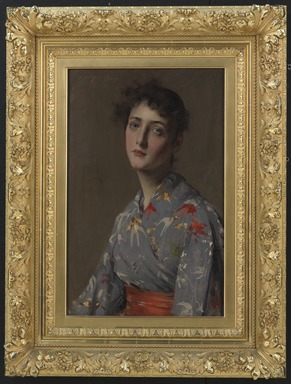Browse

| Accession # | 86.197.2 |
|---|---|
| Artist | William Merritt Chase |
| Title | Girl in a Japanese Costume |
| Date | ca. 1890 |
| Medium | Oil on canvas |
| Dimensions | 24 5/8 x 15 11/16 in. (62.5 x 39.8 cm) Frame: 36 1/4 x 27 1/2 x 4 3/4 in. (92.1 x 69.9 x 12.1 cm) |
| Signed | Signed upper left: "Wm. M. Chase" |
| Credit Line | Gift of Isabella S. Kurtz in memory of Charles M. Kurtz |
| Location | American Identities: Art Making / Centennial Era |
Curatorial Remarks: Japanese textiles, kimonos, swords, inros (small boxes that hung from the sash of kimonos), and ceramics were de rigueur in artistic American interiors of the 1890s, in keeping with Americans’ growing interest in Japanese art and aesthetics. With an abundance of Asian textiles and foreign costumes in his studio, William Merritt Chase was poised to respond to the growing popularity of Japanese costume subjects among his American and foreign peers. By the late 1880s, he began to portray selected models, often female members of his family, robed in beautifully patterned kimonos. Girl in a Japanese Costume is an example of such a work and, like the majority of his “kimono paintings,” depicts a young woman in a studio setting gazing directly at the artist, suggesting the closeness of this artist-model relationship.
The two kimonos on view nearby are unlike those that Chase would have had in his studio. Chase, like other followers of the Aesthetic Movement, would have owned silk kimonos, embroidered or hand painted in bright colors with bird and flower motifs. Japan produced many Westernized “kimonos” for customers like Chase who wanted the look but did not want to wear them “properly.” In contrast, the two kimonos on view were made for a Japanese, working-class user. They are relatively rough, in cotton and hemp, dyed once in indigo, and were made to be worn all day, every day.